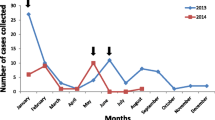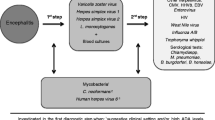Abstract
Justification
Viral encephalitis is an important cause of mortality and morbidity in children. The etiological agents are varied, and physicians treating such children often feel limited by the lack of uniform guidelines on evaluation and management of these critically ill children in resource-constrained settings.
Process
An ‘Expert Group Meeting on Viral Encephalitis in Children’ was held on 19th January, 2012 in Gurgaon, Haryana (under the aegis of PEDICON 2012, the National Conference of Indian Academy of Pediatrics). The invited experts included pediatricians and microbiologists with expertise in the relevant field. Various issues related to the subject were discussed and it was decided to bring out recommendations on the topic. The final recommendations were produced after circulating the draft document, and incorporating/discussing all changes, by e-mail.
Objectives
To aid the pediatrician in the evaluation and management of children with suspected viral encephalitis and to assist the public health authorities in acute encephalitis surveillance. These guidelines do not cover viral encephalitis in the neonatal period and in immunocompromised children, Rabies encephalitis, and chronic viral encephalitis such as Subacute sclerosing panencephalitis (SSPE).
Recommendations
Recommendation for evaluation and management of suspected viral encephalitis in children are presented. In any acute encephalitis outbreak, pediatricians should be aware of the common viral causes of encephalitis in their area, what information and samples they should collect, and the contact details of the District Surveillance Unit. Pending specific diagnosis and therapy (which may or may not be possible), prompt empirical therapy and meticulous supportive care are important to prevent ongoing brain damage, and improve outcome.
Similar content being viewed by others
References
Kneen R, Michael BD, Menson E, Mehta B, Easton A, Hemingway C, et al. Management of suspected viral encephalitis in children — Association of British Neurologists and British Pediatric Allergy Immunology and Infection Group National Guidelines. J Infect. 2012;64:449–477.
World Health Oraganisation. Acute Encephalitis Syndrome. Japanese encephalitis surveillance standards. January 2006. From WHO-recommended standards for surveillance of selected vaccine-preventable diseases. WHO/V&B/03.01. Available from: http://www.who.int/vaccines-documents/DocsPDF06/843.pdf. Accessed on 8 August, 2012.
Hollidge BS, Gonzalez-Scarano F, Soldan SS. Arboviral encephalitides: transmission, emergence, and pathogenesis. J Neuroimmune Pharmacol.2010; 5:428–442.
Sapkal GN, Bondre VP, Fulmali PV, Patil P, Gopalkrishna V, Dadhania V, et al. Enteroviruses in patients with acute encephalitis, Uttar Pradesh, India. Emerg Infect Dis.2009; 15:295–298.
Karmarkar SA, Aneja S, Khare S, Saini A, Seth A, Chauhan BK. A study of acute febrile encephalopathy with special reference to viral etiology. Indian J Pediatr. 2008; 75:801–805.
Rao BL, Basu A, Wairagkar NS, Gore MM, Arankalle VA, Thakare JP, et al. A large outbreak of acute encephalitis with high fatality rate in children in Andhra Pradesh, India, in 2003, associated with Chandipura virus. Lancet.2004; 364:869–874.
Chadha MS, Arankalle VA, Jadi RS, Joshi MV, Thakare JP, Mahadev PV, et al. An outbreak of Chandipura virus encephalitis in the eastern districts of Gujarat state, India. Am J Trop Med Hyg.2005; 73:566–570.
Harit AK, Ichhpujani RL, Gupta S, Gill KS, Lal S, Ganguly NK, et al. Nipah/Hendra virus outbreak in Siliguri, West Bengal, India in 2001. Indian J Med Res. 2006; 123:553–560.
Kalantri SP, Joshi R, Riley LW. Chikungunya epidemic: an Indian perspective. Natl Med J India. 2006; 19:315–322.
Kumar R, Tripathi S, Tambe JJ, Arora V, Srivastava A, Nag VL. Dengue encephalopathy in children in Northern India: clinical features and comparison with non dengue. J Neurol Sci. 2008; 269:41–48.
Steiner I. Herpes simplex virus encephalitis: new infection or reactivation? Curr Opin Neurol. 2011; 24:268–274.
Granerod J, Ambrose HE, Davies NW, Clewley JP, Walsh AL, Morgan D, et al. Causes of encephalitis and differences in their clinical presentations in England: a multicentre, population-based prospective study. Lancet Infect Dis. 2010; 10:835–844.
Wairagkar NS, Shaikh NJ, Ratho RK, Ghosh D, Mahajan RC, Singhi S, et al. Isolation of measles virus from cerebrospinal fluid of children with acute encephalopathy without rash. Indian Pediatr.2001; 38:589–595.
John TJ. Encephalopathy without rash, caused by measles virus? More evidence is needed. Indian Pediatr. 2003; 40:589–593.
Kumar S. Inadequate research facilities fail to tackle mystery disease. BMJ. 2003; 326:12.
Tyler KL. Emerging viral infections of the central nervous system: part 2. Arch Neurol. 2009; 66:1065–1074.
Tyler KL. Emerging viral infections of the central nervous system: part 1. Arch Neurol. 2009; 66:939–948.
Benjamin LA, Lewthwaite P, Vasanthapuram R, Zhao G, Sharp C, Simmonds P, et al. Human parvovirus 4 as potential cause of encephalitis in children, India. Emerg Infect Dis. 2011; 17:1484–1487.
Khan SA, Dutta P, Khan AM, Chowdhury P, Borah J, Doloi P, et al. West Nile virus infection, Assam, India. Emerg Infect Dis. 2011; 17:947–948.
Thakare JP, Rao TL, Padbidri VS. Prevalence of West Nile virus infection in India. Southeast Asian J Trop Med Public Health. 2002; 33:801–805.
Bondre VP, Sapkal GN, Yergolkar PN, Fulmali PV, Sankararaman V, Ayachit VM, et al. Genetic characterization of Bagaza virus (BAGV) isolated in India and evidence of anti-BAGV antibodies in sera collected from encephalitis patients. J Gen Virol. 2009;90:2644–2649.
Kumar A, Shukla D, Kumar R, Idris MZ, Misra UK, Dhole TN. An epidemic of encephalitis associated with human enterovirus B in Uttar Pradesh, India, 2008. J Clin Virol. 2011; 51:142–145.
Glaser CA, Honarmand S, Anderson LJ, Schnurr DP, Forghani B, Cossen CK, et al. Beyond viruses: clinical profiles and etiologies associated with encephalitis. Clin Infect Dis. 2006; 43:1565–1577.
Vashishtha VM, Kumar A, John TJ, Nayak NC. Cassia occidentalis poisoning causes fatal coma in children in western Uttar Pradesh. Indian Pediatr.2007; 44:522–525.
Sriramachari S. Heat hyperpyrexia: time to act. Indian J Med Res.2004; 119:vii–x.
Ghosh D, Dhadwal D, Aggarwal A, Mitra S, Garg SK, Kumar R, et al. Investigation of an epidemic of Reye’s syndrome in northern region of India. Indian Pediatr.1999;36:1097–1106.
John TJ, Date A, Patoria NK. Acute encephalopathy in children in Nagpur: similarity to Reye’s syndrome. Indian J Pediatr. 1983; 50:129–132.
John TJ. Outbreak of killer brain disease in children: mystery or missed diagnosis? Indian Pediatr. 2003;40:863–869.
Japanese Encephalitis Clinical Care Guidelines. PATH, November, 2006. Available from: www.path.org/vaccineresources/filesJE_clinical_care_guidelines_PATH.pdf. Accessed on 3 August, 2012.
Ministry of Health and Family Welfare, Government of India. Facility-based IMNCI (F-IMNCI) Participants Manual. Government of India, New Delhi, 2009. Available from:www.unicef.org/india/FBC_Participants_Manual.pdf. Accessed on 3 August, 2012.
Davis LE, Tyler KL. Molecular diagnosis of CNS viral infections. J Neurol Neurosurg Psychiatry. 2005; 76:10.
Sharma S, Kochar GS, Sankhyan N, Gulati S. Approach to the child with coma. Indian J Pediatr. 2010; 77:1279–1287.
Wang GF, Li W, Li K. Acute encephalopathy and encephalitis caused by influenza virus infection. Curr Opin Neurol. 2001; 23:305–311.
John TJ, Maiya PP, Jadhav M, Christopher S, Mukundan P. Mumps virus meningitis and encephalitis without parotitis. Indian J Med Res. 1978; 68:883–886.
Johnstone JA, Ross CA, Dunn M. Meningitis and encephalitis associated with mumps infection. A 10-year survey. Arch Dis Child. 1972; 47:647–651.
Elbers JM, Bitnun A, Richardson SE, Ford-Jones EL, Tellier R, Wald RM, et al. A 12-year prospective study of childhood herpes simplex encephalitis: is there a broader spectrum of disease? Pediatrics. 2007;119:e399–e407.
Kirkham FJ, Newton CR, Whitehouse W. Paediatric coma scales. Dev Med Child Neurol. 2008; 50:267–274.
Stevens RD, Bhardwaj A. Approach to the comatose patient. Crit Care Med. 2006; 34:31–41.
Steer AC, Starr M, Kornberg AJ. Bickerstaff brainstem encephalitis associated with Mycoplasma pneumoniae infection. J Child Neurol. 2006; 21:533–534.
Taylor DA. Impairment of consciousness and coma. Philadelphia: Elsevier, 2006.
Brazis PW, Biller J. Coma. Philadelphia: Lippincott Williams and Wilkins, 2001.
Ooi MH, Wong SC, Lewthwaite P, Cardosa MJ, Solomon T. Clinical features, diagnosis, and management of enterovirus 71. Lancet Neurol. 2010; 9:1097–1105.
Kumar R, Tripathi P, Singh S, Bannerji G. Clinical features in children hospitalized during the 2005 epidemic of Japanese encephalitis in Uttar Pradesh, India. Clin Infect Dis. 2006; 43:123–131.
Schemann JF, Doumbo O, Malvy D, Traore L, Kone A, Sidibe T, et al. Ocular lesions associated with malaria in children in Mali. Am J Trop Med Hyg. 2002; 67:61–63.
Kuno G. Serodiagnosis of flaviviral infections and vaccinations in humans. Adv Virus Res. 2003; 61:3–65.
Hua R, Chen N, Qin C, Deng Y, Ge J, Wang X, et al. Identification and characterization of a virus-specific continuous B-cell epitope on the PrM/M protein of Japanese encephalitis virus: potential application in the detection of antibodies to distinguish Japanese encephalitis virus infection from West Nile virus and Dengue virus infections. Virology J. 2010; 7:249.
Sankhyan N, Vykunta Raju KN, Sharma S, Gulati S. Management of raised intracranial pressure. Indian J Pediatr. 2010; 77:1409–1416.
Suarez JI. Hypertonic saline for cerebral edema and elevated intracranial pressure. Cleve Clin J Med. 2004; 71Suppl 1:S9–S13.
Rabinstein AA. Treatment of cerebral edema. Neurologist. 2006; 12:59–73.
Kamei S, Sekizawa T, Shiota H, Mizutani T, Itoyama Y, Takasu T, et al. Evaluation of combination therapy using aciclovir and corticosteroid in adult patients with herpes simplex virus encephalitis. J Neurol Neurosurg Psychiatry.2005; 76:1544–1549.
Martinez-Torres F, Menon S, Pritsch M, Victor N, Jenetzky E, Jensen K, et al. Protocol for German trial of acyclovir and corticosteroids in Herpes-simplex-virus-encephalitis (GACHE): a multicenter, multinational, randomized, double-blind, placebo-controlled German, Austrian and Dutch trial (ISRCTN45122933). BMC Neurol. 2008; 8:40.
Hoke CH Jr., Vaughn DW, Nisalak A, Intralawan P, Poolsuppasit S, Jongsawas V, et al. Effect of high-dose dexamethasone on the outcome of acute encephalitis due to Japanese encephalitis virus. J Infect Dis. 1992; 165:631–637.
Steiner I, Budka H, Chaudhuri A, Koskiniemi M, Sainio K, Salonen O, et al. Viral meningoencephalitis: a review of diagnostic methods and guidelines for management. Eur J Neurol. 2010; 17:999–e957.
Rotbart HA, Webster AD. Treatment of potentially life-threatening enterovirus infections with pleconaril. Clin Infect Dis. 2001; 32:228–235.
Wang SM, Lei HY, Huang MC, Su LY, Lin HC, Yu CK, et al. Modulation of cytokine production by intravenous immunoglobulin in patients with enterovirus 71-associated brainstem encephalitis. J Clin Virol. 2006; 37:47–52.
Kumar R, Tripathi P, Baranwal M, Singh S, Tripathi S, Banerjee G. Randomized, controlled trial of oral ribavirin for Japanese encephalitis in children in Uttar Pradesh, India. Clin Infect Dis. 2009;48:400–406.
Dutta K, Kumawat KL, Nazmi A, Mishra MK, Basu A. Minocycline differentially modulates viral infection and persistence in an experimental model of Japanese encephalitis. J Neuroimmune Pharmacol. 2010; 5:553–565.
George K. Investigating outbreaks of uncertain aetiologies. Indian J Med Res. 2007;125:505–507.
Japanese encephalitis vaccines. Wkly Epidemiol Rec. 2006;81:331–340.
Fischer M, Lindsey N, Staples JE, Hills S. Japanese encephalitis vaccines: recommendations of the Advisory Committee on Immunization Practices (ACIP). MMWR Recomm Rep. 2010; 59:1–27.
Halstead SB, Thomas SJ. New Japanese encephalitis vaccines: alternatives to production in mouse brain. Expert Rev Vaccines. 2011;10:355–364.
Indian Academy of Pediatrics. IAP Guidebook on Immunization, IAP, Mumbai, 2009. Available from: http://www.indg.in/health/child-health/IAP%20GUIDE%20BOOK%20ON%20IMMUNIZATION%202009-2011._pdf. Accessed on 8 August, 2012.
Government of India. Operational Guide Japanese Encephalitis Vaccination in India. Immunization Division Department of Family Welfare, Ministry of Health and Family Welfare, Government of India; September 2010. Available from http://health.bih.nic.in/Docs/Guidelines-Japanese-Encephalitis.pdf. Accessed on 11 October, 2012.
Kumar R, Tripathi P, Rizvi A. Effectiveness of one dose of SA 14-14-2 vaccine against Japanese encephalitis. N Engl J Med. 2009; 360:1465–1466.
Indian Council of Medical Research. Minutes of the meeting of the Core Committee on Vaccines. Available from: http://www.icmr.nic.in/minutesMinutes%20Core%20Committee%20on%20Vaccines.pdf. Accessed on March 28, 2012.
Author information
Authors and Affiliations
Consortia
Corresponding author
Rights and permissions
About this article
Cite this article
Sharma, S., Mishra, D., Aneja, S. et al. Consensus guidelines on evaluation and management of suspected acute viral encephalitis in children in India. Indian Pediatr 49, 897–910 (2012). https://doi.org/10.1007/s13312-012-0216-0
Published:
Issue Date:
DOI: https://doi.org/10.1007/s13312-012-0216-0




